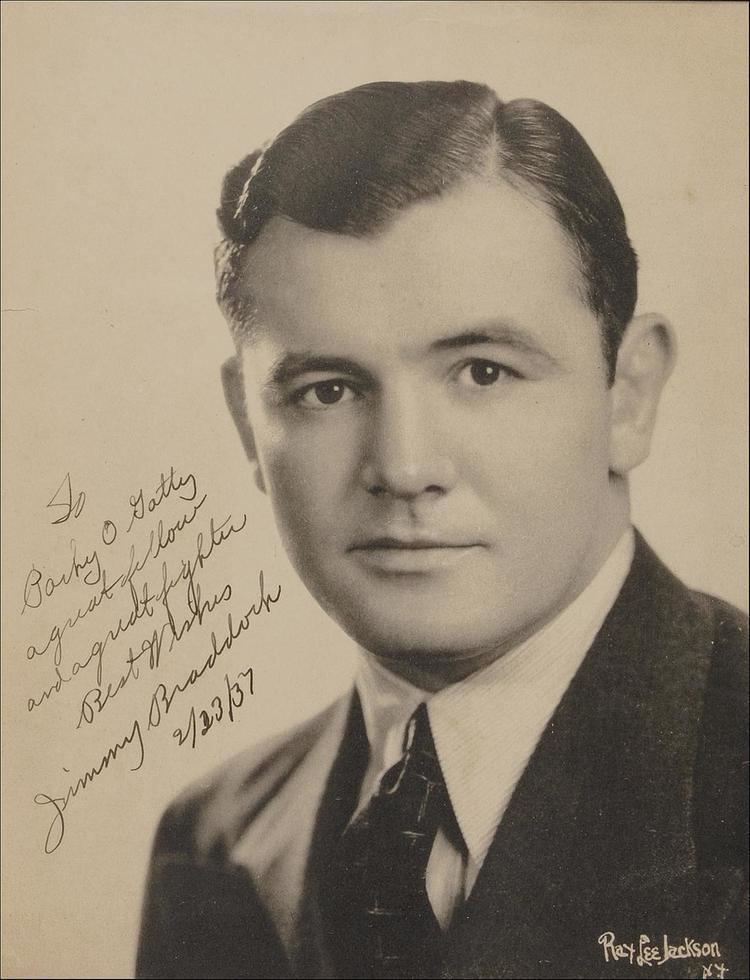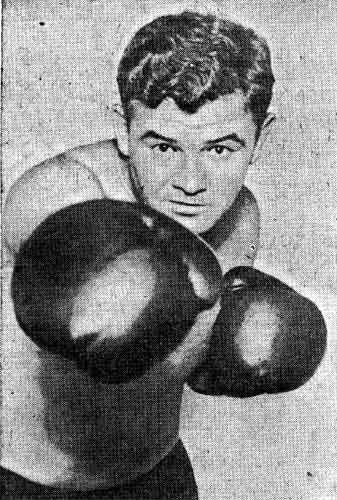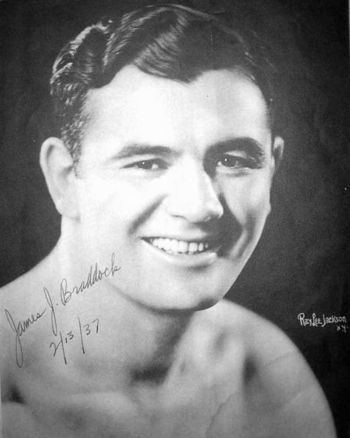Real name James Walter Braddock Name James Braddock Height 6 ft 2 ⁄2 in (1.89 m) Role Boxer | Reach 75 in (191 cm) Nationality American Movies The Super Fight | |
 | ||
Rated at MiddleweightLight heavyweightHeavyweight Spouse Mae Braddock (m. 1930–1974) Children Jay Braddock, Rosemarie Braddock, Howard Braddock Similar People | ||
James j braddock the cinderella man
James Walter "Cinderella Man" Braddock (June 8, 1905 – November 29, 1974) was an American boxer who was the world heavyweight champion from 1935 to 1937.
Contents
- James j braddock the cinderella man
- Joe louis vs james j braddock highlights classic knockout
- Early life
- Career
- Baer versus Jim J Braddock
- Heavyweight Champion
- Personal life
- Death and legacy
- References

Fighting under the name James J. Braddock (ostensibly to follow the pattern set by two prior world boxing champions, James J. Corbett and James J. Jeffries), Braddock was known for his spoiling, counterpunching style, powerful right hand and his iron chin. He had lost several bouts due to chronic hand injuries and was forced to work on the docks and collect social assistance to feed his family during the Great Depression. He made a comeback, and in 1935 he fought Max Baer for the Heavyweight title and won. For this unlikely feat he was given the nickname "Cinderella Man" by Damon Runyon. Braddock was managed by Joe Gould.

Joe louis vs james j braddock highlights classic knockout
Early life

Braddock was born in Hell's Kitchen in New York City on West 48th Street. He was one of the son out of seven children being raised by both immigrant parents; Irish mother Elizabeth O'Tool and Anglo-Irish father Joseph Braddock. He stated his life's early ambition was to play football for Knute Rockne at the University of Notre Dame, but he had "more brawn than brains."
Career

Braddock pursued boxing, turning pro at the age of 21, fighting as a light heavyweight. The first fight Braddock fought in a ring occurred on November 27, 1923. After three years, Braddock's record was 44–2–2, with 21 knockouts.

In 1928 he pulled off a major upset by knocking out highly regarded Tuffy Griffiths. The following year he earned a chance to fight for the title, but he narrowly lost to Tommy Loughran in a 15-round decision. Braddock was greatly depressed by the loss and badly fractured his right hand in several places in the process. His career suffered as a result, as did his disposition.

His record for the next 33 fights fell to 11–20–2. With his family in poverty during the Great Depression, Braddock had to give up boxing for a little while and worked as a longshoreman. Due to frequent injuries to his right hand, Braddock compensated by using his left hand during his longshoreman work, and it gradually became stronger than his right. He always remembered the humiliation of having to accept government relief money, but was inspired by the Catholic Worker Movement, a Christian social justice organization founded by Dorothy Day and Peter Maurin in 1933 to help the homeless and hungry. After his boxing comeback, Braddock returned the welfare money he had received and made frequent donations to various Catholic Worker Houses, including feeding homeless guests with his family.
Baer versus Jim J. Braddock
In 1934 Braddock was given a fight with the highly touted John "Corn" Griffin. Although Braddock was intended simply as a stepping stone in Griffin's career, he knocked out the "Ozark Cyclone" in the third round. Braddock then fought John Henry Lewis, a future light heavyweight champion. He won in one of the most important fights of his career. After defeating another highly regarded heavyweight contender, Art Lasky, whose nose he broke during the bout on March 22, 1935, Braddock was given a title fight against the World Heavyweight Champion, Max Baer.
Baer hardly trained for the bout. Braddock, on the other hand, was training hard. "I'm training for a fight. Not a boxing contest or a clownin' contest or a dance", he said. "Whether it goes 1 round or 3 rounds or 10 rounds, it will be a fight and a fight all the way... When you've been through what I've had to face in the last two years, a Max Baer or a Bengal tiger looks like a house pet. He might come at me with a cannon and a blackjack and he would still be a picnic compared to what I've had to face."
Considered little more than a journeyman fighter, Braddock was hand-picked by Baer's handlers because he was seen as an easy payday for the champion, despite his recent impressive victories. Instead, on June 13, 1935, at Madison Square Garden Bowl, Braddock won the Heavyweight Championship of the World as the 10-to-1 underdog in what was called "the greatest fistic upset since the defeat of John L. Sullivan by Jim Corbett".
During the fight, a dogged Braddock took a few heavy hits from the powerful younger champion (30 years vs 26 years for Baer), but Braddock kept coming, wearing down Baer, who seemed perplexed by Braddock's ability to take a punch. In the end, the judges gave Braddock the title with a unanimous decision.
Heavyweight Champion
Braddock suffered from problems with his arthritic hands after injuries throughout his career and, in 1936, his title defense in Madison Square Garden against the German Max Schmeling was canceled under suspicious circumstances. Braddock argued he would have received only a US$25,000 purse against Schmeling, compared to $250,000 against rising star Joe Louis. There was also concern that if Schmeling won, the Nazi government would deny American fighters opportunities to fight for the title. Finally, American commentators had expressed opposition to the fight in light of the connections between Schmeling and Adolf Hitler, with whom the German fighter had been associated after his earlier victory over Louis.
Personal life
Braddock married Mae Fox in 1930 and the couple had three children, James (Jay), Howard and Rosemarie.
Braddock enlisted in the U.S. Army in 1942 and became a 1st Lieutenant. Braddock served on the island of Saipan, where he trained enlisted men in hand-to-hand combat.
Upon return, he worked as a marine equipment surplus supplier and helped construct the Verrazano Bridge in the early 1960s.
Death and legacy
After his death in 1974 at the age of 69, James J. Braddock was interred in the Mount Carmel Cemetery in Tenafly, New Jersey. He was inducted into the International Boxing Hall of Fame in 2001. James J. Braddock North Hudson County Park in North Bergen, New Jersey is named in his honor.
The 2005 biographical film Cinderella Man tells Braddock's story. Directed by Ron Howard, it stars Russell Crowe as Braddock and Renée Zellweger as his wife, Mae. The film had an estimated budget of $88 million and grossed $108.5 million worldwide. Crowe's performance earned him a Golden Globe nomination for Best Actor. Paul Giamatti, playing Braddock's manager Joe Gould, was nominated for the Academy Award for Best Supporting Actor. The role of neighbor Sara Wilson was played by Rosemarie DeWitt, who is Braddock's real-life granddaughter (daughter of Braddock's daughter Rosemarie Braddock and husband Kenny DeWitt). The film received mostly positive reviews.
